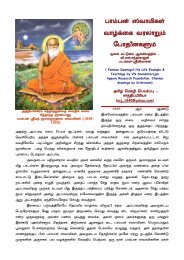MALAYSIAN HINDU PILGRIMAGE: KAVADI ... - Murugan Bhakti
MALAYSIAN HINDU PILGRIMAGE: KAVADI ... - Murugan Bhakti
MALAYSIAN HINDU PILGRIMAGE: KAVADI ... - Murugan Bhakti
You also want an ePaper? Increase the reach of your titles
YUMPU automatically turns print PDFs into web optimized ePapers that Google loves.
Not all kavadis are borne for <strong>Murugan</strong>. Indeed, a wide range of deities are represented at Thaipusam.Kavadis may be carried in honour of other Saivite deities (Siva, Ganesha, Parvati), Vaisnavite deities(principally Krishna, Rama and Hanuman) and village deities such as Muniyanti, Madurai, Viran,Kaliamman and Durga. The honouring of “little deities” and the accompanying and “transgressive”worship (Visvualingam) which contradicts the basic Agamic principles, has elicited much criticismfrom the putative defenders of an imagined Hindu orthodoxy (Govinda Raj). However, it is worthnoting the worship of “foreign” or “lesser” deities is nearly always permeated with the ritual and fallswithin the received framework of the established <strong>Murugan</strong> paradigm.A subsidiary theme is that of asceticism. For at the time of his altercation with Itampan, <strong>Murugan</strong> hadrenounced the world and family life and as a sannysasin (ascetic renunciate) had repaired to Palani onhis self imposed exile to penetrate to the heart of truth. (Clothey:118)Thaipusam is celebrated on the day in which the asterism Pucam is on the ascent in the month of Tai(January-February). The presiding star is the planet Brihaspati (Jupiter), which is consideredbenificient. (Arasaratnam:1966:p.13). Of especial significance is that Pucam falls on or near the fullmoon day. In the <strong>Murugan</strong> tradition the full moon implies completion, fulfillment and total maturity inpowers (Clothey: pp 125-136). Moreover the asterism Pucam is reputed to be that of Tanatapani,which represents a staff, suggesting asceticism. And indeed <strong>Murugan</strong> is known as Tanta Yutapani atPalani and is represented as an ascetic.<strong>PILGRIMAGE</strong> AND <strong>KAVADI</strong> WORSHIP IN MALAYSIAWithin the Hindu tradition, pilgrimage is known as tirtha-yatra, i.e. a journey (yatra) to a “ford” or“crossing place” (tirtha). While some tirtha-s may actually consist of river crossings, the term may bemore literally interpreted to incorporate any recognized pilgrimage centre, any one of a broad range ofliminal median locations in which the boundary between human and divine worlds is both permeableand negotiable. (Moronis) In the most general sense, then, a pilgrimage may be viewed as a journey toa destination (“crossing place”) where deities normally transcendent are both imminent and accessible.A pilgrimage centre may be conceptualized as an axis mundi, a central pivot of the cosmos, which isoutside mundane space and time, even though it is a visible site on earth as well. (Fuller:208) Theshrine is idealized as a ritually ordered universe and the gatekeeper marks the point of transition fromthe outside world, a place marked by the chaos, sorrow and flux of the kaliyuga (current age), to theotherworldly shrine. (Shulman) The heart of the shrine is suffused with sacred power which forms adense and patterned representation of ritual symbolism. (Moronis)One of the most distinguishing features of Tamil purana-s is the consistent localization of mythicactions, so that pilgrimage sites are firmly linked to a particular phase of a deity’s history. Deities arethus often rooted in a particular territory which is rightfully owned by them, and considered to be theirprovince. (Moreno:p.112) Despite the multiplicity of pilgrimage sites in South India, each shrine isviewed as the centre of the universe, the one place that is directly linked to the other worlds. Just aslocalization establishes a nexus between place and mythic action, so it determines and prescribes theforms of ritual worship considered appropriate at a given pilgrimage centre.In sum, pilgrimage may be viewed as a journey from the periphery, from the mundane world of thekaliyuga, to the centre, the axis mundi, where direct communication can be made with the imminentdeity. The journey to the shrine is an integral defining aspect of pilgrimage. This journey begins whenthe aspirant begins a set of purificatory rituals which places him/her outside mundane societal routines.The tapa-s (austerities) and asceticism required of the pilgrim are more usually associated with thesannyasin, and indeed pilgrimage is a means by which the devotee may temporarily assume thecultural idea of renunciation. (Gold) The culmination of pilgrimage is the direct and personal approachmade by the aspirant to the deity and the transformation this experience elicits within the devotee.Pilgrimage deals with a wide variety of motives and provides a structure which accommodates themall. While the pilgrimage furnishes the devotee with both material reward (bhukti) and release (mukti),the goals of most South Indian pilgrims are essentially practical, in that the worshipper seeks thedeity’s intervention and assistance to help him/her in everyday life. Pilgrimage is an act of devotionwhich stresses the qualities of humility, faith and submission, and highlights the aspirant’s willingness


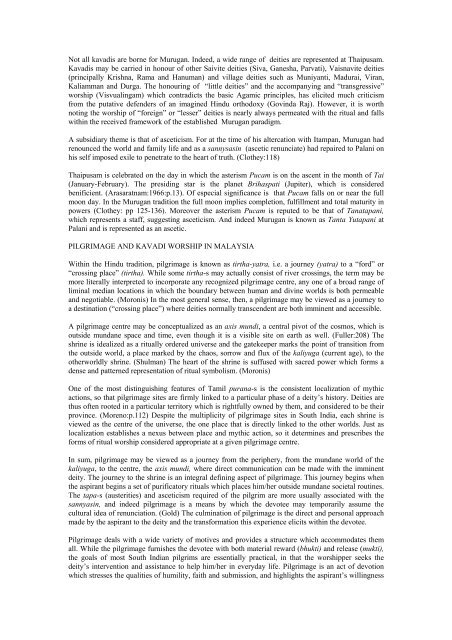
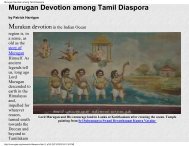


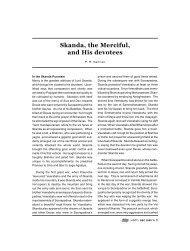

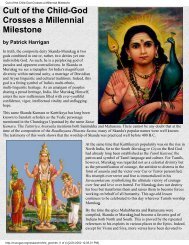
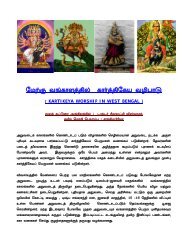
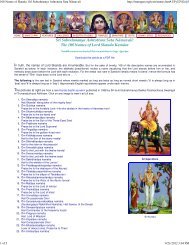
![gHdp k]y Myaj;jpw;F ghj ahj;jpiu fpuhkpa gHf;f Kiwfs;](https://img.yumpu.com/10245948/1/184x260/ghdp-ky-myajjpwf-ghj-ahjjpiu-fpuhkpa-ghff-kiwfs.jpg?quality=85)

